
The London Borough of Islington is a London borough which forms part of Inner London, England. Islington has an estimated population of 215,667. It was formed in 1965, under the London Government Act 1963, by the amalgamation of the metropolitan boroughs of Islington and Finsbury.

Bloomsbury is a district in the West End of London, part of the London Borough of Camden in England. It is considered a fashionable residential area, and is the location of numerous cultural, intellectual, and educational institutions. Bloomsbury is home of the British Museum, the largest museum in the United Kingdom, and several educational institutions, including University College London and a number of other colleges and institutes of the University of London as well as its central headquarters, the New College of the Humanities, the University of Law, the Royal Academy of Dramatic Art, the British Medical Association and many others. Bloomsbury is an intellectual and literary hub for London, as home of world-known Bloomsbury Publishing, publishers of the Harry Potter series, and namesake of the Bloomsbury Group, a group of British intellectuals which included author Virginia Woolf, biographer Lytton Strachey, and economist John Maynard Keynes.

Canonbury is an area in London, forming part of the London Borough of Islington. It is located within the area between Essex Road, Upper Street and Cross Street and either side of St Paul's Road in North London.

Islington is an inner-city area of north London, England, within the wider London Borough of Islington. It is a mainly residential district of Inner London, extending from Islington's High Street to Highbury Fields, encompassing the area around the busy High Street, Upper Street, Essex Road, and Southgate Road to the east.

Islington was a civil parish and metropolitan borough in London, England. It was an ancient parish within the county of Middlesex, and formed part of The Metropolis from 1855. The parish was transferred to the County of London in 1889 and became a metropolitan borough in 1900. It was amalgamated with the Metropolitan Borough of Finsbury to form the London Borough of Islington in Greater London in 1965.

The London Borough of Islington is short of large parks and open spaces, given its status in recent decades as a desirable place of residence. In fact, Islington has the lowest ratio of open space to built-up areas of any London borough. The largest continuous open space in the borough, at 11.75 hectares, is Highbury Fields.

Lonsdale Square is a garden square in the Barnsbury district of Islington, North London. It is bounded by unusual Tudor Gothic Revival terraced houses, with picturesque gables and Elizabethan-style windows, and is probably unique among squares. All the houses are listed buildings. The central public garden contains flower beds and mature trees.
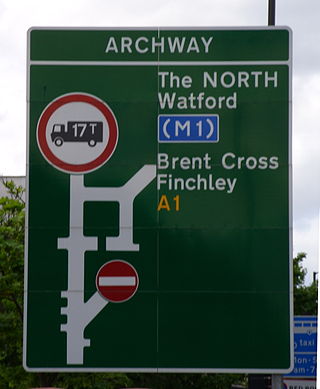
The A1 in London is the southern part of the A1 road. It starts at Aldersgate in the City of London, passing through the capital to Borehamwood on the northern fringe of Greater London, before continuing to Edinburgh. The road travels through the City and three London boroughs: Islington, Haringey and Barnet, which include the districts of Islington, Holloway, Highgate, Hendon and Mill Hill, and travels along Upper Street and Holloway Road, crossing the North Circular Road in Hendon, a district in the London Borough of Barnet.
Henry William Inwood was an English architect, archaeologist, classical scholar and writer. He was the joint architect, with his father William Inwood of St Pancras New Church.

The Church of St Mary the Virgin is the historic parish church of Islington, in the Church of England Diocese of London. The present parish is a compact area centered on Upper Street between Angel and Highbury Corner, bounded to the west by Liverpool Road, and to the east by Essex Road/Canonbury Road. The church is a Grade II listed building.

Angel is an area on the northern fringes of Central London within the London Borough of Islington. It is 2 miles (3.2 km) north-northeast of Charing Cross on the Inner Ring Road at a busy transport intersection. The area is identified in the London Plan as one of 35 major centres in London. It is a significant commercial and retail centre, and a business improvement district. Angel straddles the ancient boundary of the parishes of Clerkenwell and Islington that later became the metropolitan boroughs of Finsbury and Islington. It is named from the former Angel Inn which stood on the corner of Islington High Street and Pentonville Road. Since 1965 the whole area has formed part of the London Borough of Islington in Greater London.

Francis Edwards (1784–1857) was a British architect of the Georgian and early Victorian periods, who worked extensively in the London area.

Canonbury Square is a garden square in Canonbury, North London. It is bounded by terraces of mostly Georgian houses, many of which are listed buildings. The central public gardens contain attractive flower beds and several London plane trees of great age. The Evening Standard newspaper described it in 1956 as “London’s most beautiful square”. Many significant figures from the arts and literary worlds have lived in the square, including George Orwell, Evelyn Waugh, Samuel Phelps, Duncan Grant and Vanessa Bell.

Canonbury House is the name given to several buildings in the Canonbury area of Islington, North London which once formed the manor house of Canonbury, erected for the Canons of St Bartholomew's Priory between 1509 and 1532. The remains today consist of Canonbury Tower and several buildings from the 1790s, some of which incorporate parts of the late 16th-century manor house. Today, the Tower and the other buildings, including a 1790s building today also named "Canonbury House", are arranged around the road named Canonbury Place.

Barnsbury Square is a garden square in the Barnsbury district of Islington, North London. It is bounded by Victorian villas and Regency and Victorian terraces, several of which are listed buildings. The central public gardens contain flower beds and mature trees.
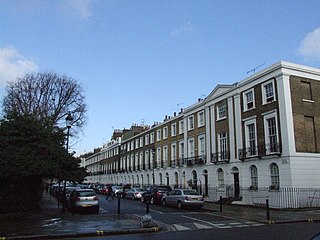
Gibson Square is a garden square in the Barnsbury district of Islington, North London. It is bounded by Regency and Victorian terraced houses, most of which are listed buildings. The central public gardens contain flower beds and mature trees, and an unusual building resembling a classical temple.

Milner Square is a garden square in the Barnsbury district of Islington, North London. It is bounded by early Victorian terraced houses, which are all listed buildings. Historic England describes it as "important for the radical logic of its design, of a type rarely seen outside Scotland and the North, and unlike anything in London."
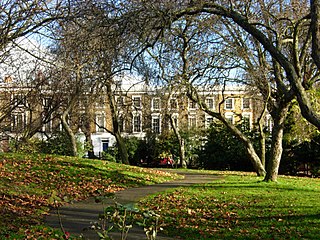
Thornhill Square together with the adjacent Thornhill Crescent form a garden square in the Barnsbury district of Islington, North London. It is bounded by Victorian terraced houses, all of which are listed buildings. The central public gardens contain flower beds, mature trees, and a children's play area, and the Crescent gardens surround the Victorian Church of St Andrew.
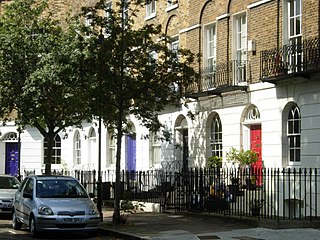
Cloudesley Square is a square in the Barnsbury district of Islington, North London. It is bounded by Georgian terraced houses, all of which are listed buildings. The central area is occupied by the Gothic Revival former Holy Trinity Church, designed by Charles Barry.
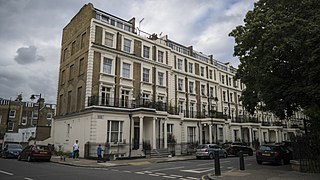
Arundel Square is a garden square in Barnsbury, North London. It is bounded on three sides by terraces of Victorian houses, and on the fourth with modern flats. The central public gardens contain mature trees, attractive flower beds and playground equipment.



















